Related Research Articles
Pope Eleutherius, also known as Eleutherus, was the bishop of Rome from c. 174 to his death. His pontificate is alternatively dated to 171-185 or 177-193. He is venerated as a Saint in the Catholic Church.

Llandeilo is a town and community in Carmarthenshire, Wales, situated at the crossing of the River Towy by the A483 on a 19th-century stone bridge. Its population was 1,795 at the 2011 Census. It is adjacent to the westernmost point of the Brecon Beacons National Park. The town is served by Llandeilo railway station on the Heart of Wales Line.
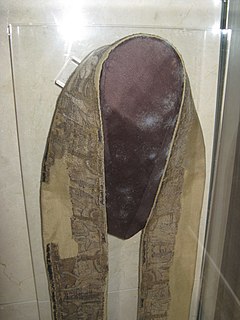
Paul Aurelian was a 6th-century Welshman who became first bishop of the See of Léon and one of the seven founder saints of Brittany. He allegedly died in 575, rumoured to have lived to the age of 140, after having been assisted in his labors by three successive coadjutors. This suggests that several Pauls have been conflated. Gilbert Hunter Doble thought that he might have been Saint Paulinus of Wales.

Archenfield is the historic English name for an area of southern and western Herefordshire in England. Since the Anglo-Saxons took over the region in the 8th century, it has stretched between the River Monnow and River Wye, but it derives from the once much larger Welsh kingdom of Ergyng.
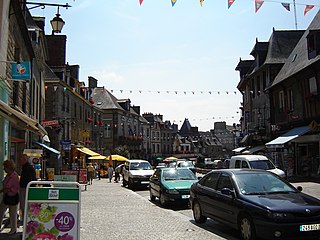
Dol-de-Bretagne, cited in most historical records under its Breton name of Dol, is a commune in the Ille-et-Vilaine département in Brittany in northwestern France.
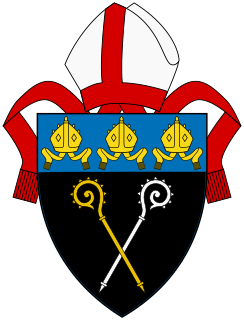
The Diocese of Llandaff is an Anglican diocese that traces its roots to pre-Reformation times as heir of a Catholic bishopric. It is headed by the Bishop of Llandaff, whose seat is located at the Cathedral Church of Saint Peter and Saint Paul in Llandaff, a suburb of Cardiff. It currently covers most of the former Welsh county of Glamorgan, but once stretched from the River Towy to the middle of the Wye Valley.

The Bishop of Llandaff is the ordinary of the Church in Wales Diocese of Llandaff.
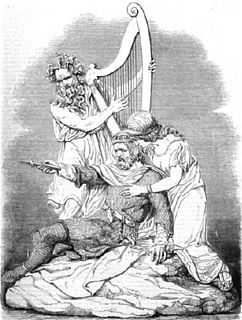
Tewdrig ap Teithfallt, known simply as Tewdrig, was a king of the post-Roman Kingdom of Glywysing. He abdicated in favour of his son Meurig (Maurice) and retired to live a hermitical life, but was recalled to lead his son's army against an intruding Saxon force. He won the battle, but was mortally wounded.
Athrwys ap Meurig was a prince, and possibly king, of Gwent and Glywysing in Wales. He was the son of King Meurig ap Tewdrig and the father of the later king Morgan ab Athrwys. It is possible he died before his father Meurig and did not live to rule as king himself.
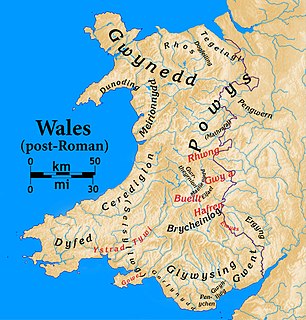
Ergyng was a Welsh kingdom of the sub-Roman and early medieval period, between the 5th and 7th centuries. It was later referred to by the English as Archenfield.

Dubricius or Dubric was a 6th-century British ecclesiastic venerated as a saint. He was the evangelist of Ergyng and much of south-east Wales.

Saint Oudoceus (Latin) or Euddogwy (Welsh) is generally known as the third Bishop of Llandaff in South Wales. In reality he was probably a 7th-century bishop at Llandeilo Fawr. Wendy Davies puts his episcopal reign between about 650 and 700.
Gwrgan Fawr was a king of Ergyng, a south-east Welsh kingdom of the Early Middle Ages.
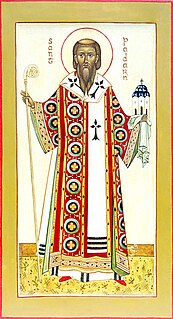
Padarn was an early 6th century sanctified British Christian abbot-bishop who founded St Padarn's Church in Ceredigion, Wales. The first bishop of Braga and Saint Paternus of Avranches in Normandy appear to be the same person. Padarn built a monastery in Vannes and is considered one of the seven founding saints of Brittany. Padarn's early vita is one of five insular and two Breton saints' lives that mention King Arthur independently of Geoffrey of Monmouth's Historia Regum Britanniae.

Merthyr Dyfan or Dyfan is a northeastern suburb of Barry in the Vale of Glamorgan, in south Wales, formerly an independent medieval village. It is also an ecclesiastical parish and a formal electoral ward of the Vale of Glamorgan. It borders Colcot to the west, Buttrills to the southwest and Gibbonsdown to the southeast. Its main roads are Merthyr Dyfan Road, a hilly road leading down from the A4050 road which leads into Wenvoe and Cardiff; and Skomer Road which separates it from Gibbonsdown and eventually also leads to the A4050 road. Merthyr Dyfan contains an old parish church, Barry Rugby Club, Bryn Hafren Comprehensive School and the Master Mariner Pub and Holm View Leisure Centre, although the last two could be considered to be in northern Gibbonsdown.

Saint Teilo, also known by his Cornish name Eliud, was a British Christian monk, bishop, and founder of monasteries and churches. He was from Penalun (Penally) near Tenby in Pembrokeshire, south Wales.
Budic II, formerly known as Budick, was a king of Cornouaille in Brittany in the late 5th and early 6th centuries. He was father of Hoel as well as several Celtic saints.

Deruvian, also known by several other names including Damian, was a possibly legendary 2nd-century bishop and saint, said to have been sent by the pope to answer King Lucius's request for baptism and conversion to Christianity. Together with his companion St Fagan, he was sometimes reckoned as the apostle of Britain. King Lucius's letter may represent earlier traditions but does not appear in surviving sources before the 6th century; the names of the bishops sent to him does not appear in sources older than the early 12th century, when their story was used to support the independence of the bishops of St Davids in Wales and the antiquity of the Glastonbury Abbey in England. The story became widely known following its appearance in Geoffrey of Monmouth's pseudohistorical History of the Kings of Britain. This was influential for centuries and its account of SS Fagan and Deruvian was used during the English Reformation to support the claims of both the Catholics and Protestants. Geoffrey's account is now considered wholly implausible, but Christianity was well-established in Roman Britain by the third century. Some scholars therefore argue the stories preserve a more modest account of the conversion of a Romano-British chieftain, possibly by Roman emissaries by these names.
Isfael or Ismael, often anglicized as Ishmael, was a 6th-century medieval Welsh bishop of Rhos and saint. He was allegedly also a Breton prince of Armorica.
Clydog was a sixth-century Welsh king of Ergyng who became a saint. His feast day is traditionally held on 3 November but is also celebrated on 19 August.
References
- 1 2 "Saint Inabwy". Early British Kingdoms.
- ↑ Chris Barber (2016). King Arthur: The Mystery Unravelled.